An illustrated alphabet card by Hyojung Ryu: What am I? and Who am I?
By overlapping alphabet card it creates a very interesting visual and also it can enhance the impression for children to learn.
piak (splash) whatever i have :D
An illustrated alphabet card by Hyojung Ryu: What am I? and Who am I?
By overlapping alphabet card it creates a very interesting visual and also it can enhance the impression for children to learn.
A Look At Breastfeeding in Singapore: Trends, Practices and Support
So more women are breastfeeding, but where are they?
Confinement Practices
Many new mothers in Singapore follow traditional confinement practices. The new mother observes a period (between 30 and 44 days) of being confined to her home to rest following the birth of her baby, where she follows practices that protect her and her baby as well as enabling her to recover from the delivery. These practices vary between different ethnic groups and often include eating confinement foods that aid in recovery and boosting breastmilk supply. These traditional practices mean that many new mums don’t venture out with their new babies.
Where can mothers go for breastfeeding help in Singapore?
Unlike most European countries, Australia and New Zealand, Singapore has no routine follow-up care once mum and baby are discharged from hospital after birth. Given that most mums are discharged between 2 and 4 days after deliver, many experience breastfeeding challenges once they return home.
Hospitals
Many mothers are unaware that they can return to the hospital to see the lactation consultant there. The postpartum units also offer guidance on other babycare issues.
Paediatricians and polyclinic staff
Mums can access polyclinics or paediatricians to monitor the growth and well being of their babies. However, these professionals may not have received adequate breastfeeding training.
Social media and the Internet
Many mums rely on social media and Google to answer their questions on breastfeeding. It’s important that mothers check to see that the source of information is reliable as misinformation abounds online.
Breastfeeding Mothers’ Support Group of Singapore (BMSG)
The BMSG offers a telephone helpline and email counseling for mothers needing breastfeeding advice.
While these avenues are lifelines for many mothers, there are few options for face-to-face expert support after being discharged from the hospital. A small number of mothers choose to consult a private lactation consultant. This lack of support after returning home from hospital may be a contributing factor for why many mums giving up breastfeeding in the early weeks.
Breastfeeding in public?
There is no legal ruling about breastfeeding publicly in Singapore. Public breastfeeding is not against the law per se, but breastfeeding mums are also not legally protected.
The Breastfeeding Mother’s Support Group received clarification on nursing in public from the then Director of Public Affairs for the Singapore Police Force in 1999. In a letter, the SPF states that “It is not an offence to breastfeed in public if the woman is decently clad and she does not expose her breast more than is necessary to breastfeed her child.” The statement is somewhat subjective and is perhaps one of the reasons why mothers go to so much trouble to cover up when breastfeeding in public. As is the case for new mums all over the world, mothers here may be embarrassed and anxious about revealing any breast or post-pregnancy tummy, preferring to breastfeed in private.
NTUC has published a map of Public Nursing Rooms in Singapore and various other organisations (including us at Sassy Mama!) have also produced their own guides to finding appropriate breastfeeding rooms in Singapore.
Arguments on Breastfeeding in Public
The reasons of agreeing public breastfeeding:
The reasons of against public breastfeeding:
We totally agree that the sexual purpose of breasts is to portray fertility however the practical purpose is to feed a women’s child. Arguing that a woman’s breasts should be kept private in order to honor her husband objectifies her and negates her choice as a woman to breastfeed. Another opinion is that they are uncomfortable with breastfeeding is not because women’s breast are extremely sexualized in our culture, but they are uncomfortable showing something that we as a society has deemed to be a private-behind closed doors- type of thing.
The point is often made that people “don’t want to see that”. “If you don’t want to see it, don’t look.” Beneath the self-important silliness of the argument, there is a layer of disrespect and inconsideration festering. Basically, we have to taught to be “treat others the way you want to be treated,” so if you want to be treated with respect, then you also need to respect others.
The responses from article,
“I understand breastfeeding is a natural thing, but just because it is a natural thing doesn’t mean everyone wants to see it. It was not for the reason of them being “sexualized,” just the simple fact that I was uncomfortable with it. It just seems lately that all the breastfeeding moms want is to be able to breastfeed in public comfortably, but they seem to attack other people who feel uncomfortable with it. All I’m saying is if you want people to respect your breastfeeding, then you need to respect the fact that not everybody is comfortable with it. “
Retrieved from
See How People React In This “Sexy Vs. Breastfeeding” In Public Social Experiment
Breastfeeding in Public
To Breastfeed in Public or To Not… That is the Question
7 Ignorant Things People Say About Breastfeeding…
Why Are Some People Against Breastfeeding in Public
Is public breastfeeding appropriate?
Expressing and storing breast milk
JoeySalads – Sexy vs Breastfeeding in Public (Social Experiment)
A YouTuber JoeySalads, has created a video to test out how people react to a mother breastfeeding her child with no cover and how others reacted to a young woman having her breast/cleavage showing in a low cut shirt.
The video shows these two women sitting on the same bench. The first to sit was the “young beautiful women,” although she received looks, only had one person stopped to talk to her, and he inevitably sat down and began flirting with the young women. Once the video moved on to the mother breastfeeding, she immediately gained attention. The first person shown walked up and angrily says to the mother breastfeeding “Seriously Ma’am, you have to do that here? That’s disgusting.” While others seem to walk by this mother breastfeeding her child and make snide remarks like “That’s so Disgusting,” one woman was very supportive.A young mother who happens to be due in less than a month.
In the second half of the video, the woman who is breastfeeding her child sit directly next to the young women with her cleavage/breast out. Many men stopped to tell the mother that she was being “gross” and “disgusting.” One man blatantly said that it was okay for the young women to have her breast/cleavage showing because “that’s hot,” but it’s not okay for the mother to have her breast out and feed her child because “that’s disgusting.”
Retrieved from To Breastfeed in Public or To Not… That is the Question
There is a campaign called BFF (Breastfeeding Friend) in Singapore. It is aims to improve public acceptance of nursing mums. They approached local establishments like cafes and restaurants to pledge to their cause to welcome mothers to nurse their babies openly at their premises. So far, there are over 50 places have joined BFF campaign.
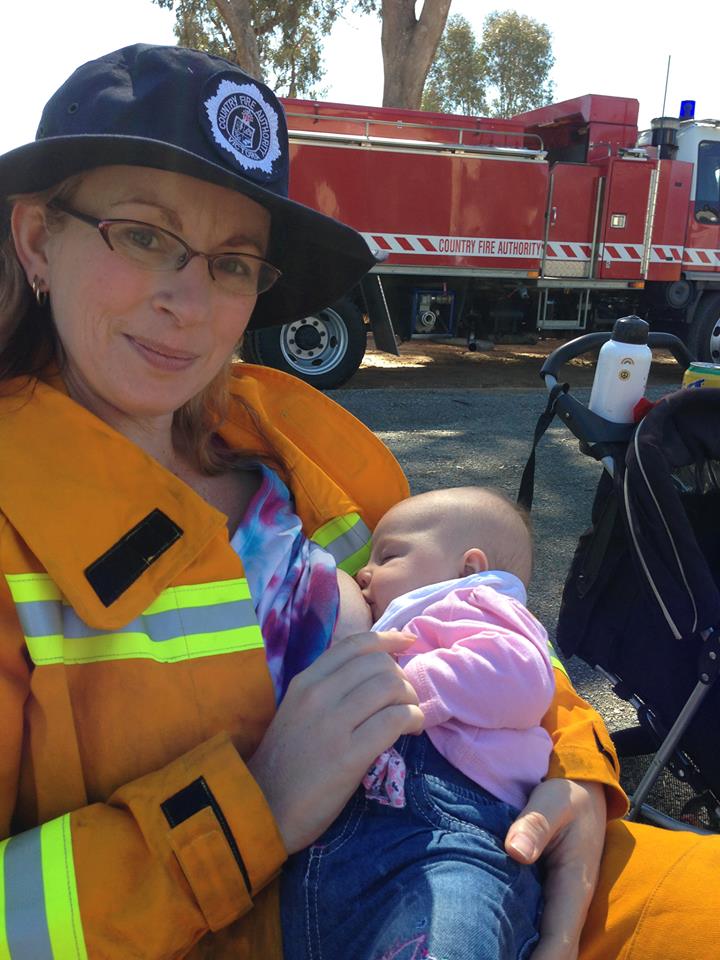 Recently, a photo posted on the CFA (Country Fire Authority) Facebook page of a breastfeeding volunteer firefighter caused a huge stir, with the typical media reaction.
Recently, a photo posted on the CFA (Country Fire Authority) Facebook page of a breastfeeding volunteer firefighter caused a huge stir, with the typical media reaction.
Ms Pan, who runs Jen Pan Photography with her husband Ray, raise out the voice with a three-part personal photo project titled The Magical World of Breastfeeding.
The criticisms are a sign that breastfeeding is still not normalized in our society.
Small summary for my project:
1)family tree (4 generations, start from my grandparents)
what: to discover the relationships between my family and the extended family based on the year of birth and generation
how: design a visualization diagram based on the concentric tree rings instead of a vertical hierarchical chart (information: english name, chinese name, year of birth, relationship)
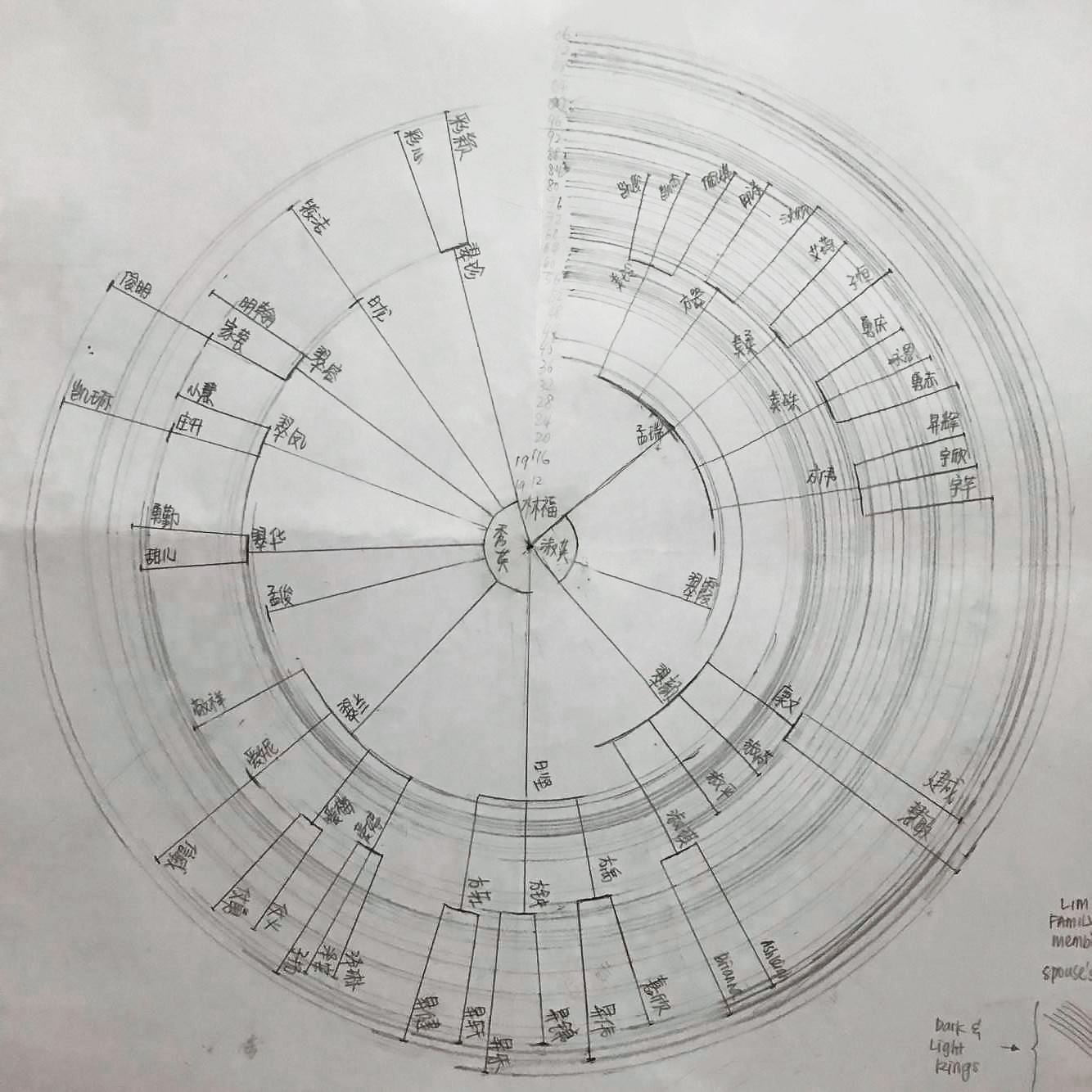
2)migration path of my family (map)
what: to show the migration path of my family from the start of my grandparents immigrated from China to Malaysia. Also, to show the fact that the children have moved to other cities to seek for more job opportunities after they grew up.
how:
Go back to the initial mind mapping of time concept, order and sequence have mentioned in the previous post. From there, I integrated the meaning of Lin 林, the tree. From there came to the idea of the order and the sequence of a tree grows. It starts with a seed and needs time and nutrition to produce all of its parts – roots, trunk, branches, leaves, flowers and fruits – and to grow larger.
So, I am thinking to use the growth of tree to be the idea of visualisation diagram and integrate with Malaysia map to show the migration path of my family which is
“Root-seeking culture is part of traditional Chinese culture, and features elements suchas ethnic groups, family names, characters, and classics. As its name suggests, root-seeking culture refers to practices of seeking one’s roots and finding one’s blood ties andemotional bonds.”
Resources: Root-seeking culture booms in China
However, generations represented by different part of the tree are my perspective for now since we will grow up and the role will keep changing and changing. For visual and aesthetic aspects, I have no idea of how to fit this idea into map to show the migration for now.
3)memories and stories
what: mainly to narrate my grandparents’ story. eg, how he survived in those tough times, how he started his business, how he taught his children and etc.
how: stories, old photograph, some documents
Resources :
Forest Fact: How a tree grows
Tree trunks – general facts and information
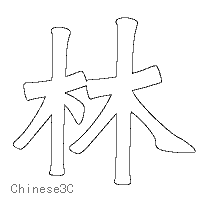
Continue researching on Chinese Surname and developing the visual concept.
林
No. of Chinese Strokes : 8 (More research on the meaning of 8)
PinYin (Chinese Pronounce) : Lin
Min Nan (Hokkien)/ Cantonese (Malaysia/Singapore) : Lim
Cantonese (Hong Kong): Lam
English Meaning : Woods, Forest, The Man of Wood
Meaning of Number 8 in Chinese culture
1)Eight (Ba in Chinese) has the similar pronunciation with 发 (Fa, meaning wealth or fortune), this number is very welcome among Chinese people.
2)The Chinese deem number eight as a number of initiations and spiritual ascension because eights represent the forces within the world of phenomenon. For example, Eight immortals, Eight Diagrams, Ba Zi.
Study on Tree Diagram
Tree Diagram :
1) a way of representing the hierarchical nature of a structure in a graphical form.
2) resembles a tree, even though the chart is generally upside down compared to an actual tree, with the “root” at the top and the “leaves” at the bottom.
Nodes: the tree elements
Branches: the lines connecting elements
Leaf nodes/ end-nodes/ leaves: Nodes without children
Root/ root node: starting node, a member that has no superior in finite tree structure
Fan Chart:
1) features a half circle chart with concentric rings
2) the person of interest is the inner circle, the second circle is divided in two (each side is one parent), the third circle is divided in four, and so forth.
3) depict paternal and maternal ancestors.
Resources : Wikipedia Family Tree, Wikipedia Tree Structure
Besides having the conventional family tree with “root” at top and “leaves” at the bottom, are there any other direction that can consolidate the visual concept of my family chart? How can I link my family chart to the meaning of 林 “Lin”, which is woods/ forest/ the man of wood? How can I link back the whole family chart to the concept of TIME? Can woods or forest tell time?
The questions above linked to the answer of the way to determine the age of a tree.
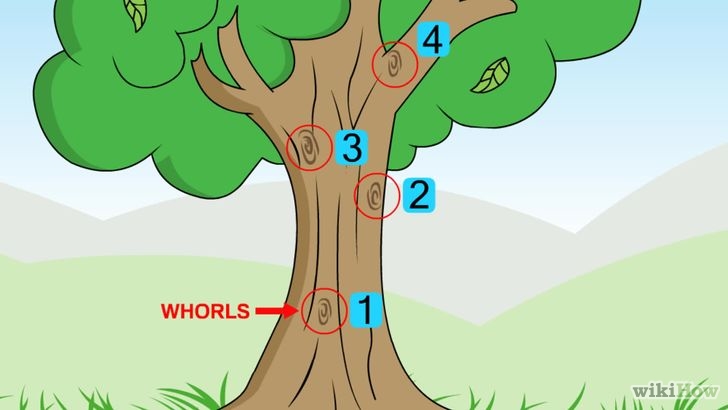
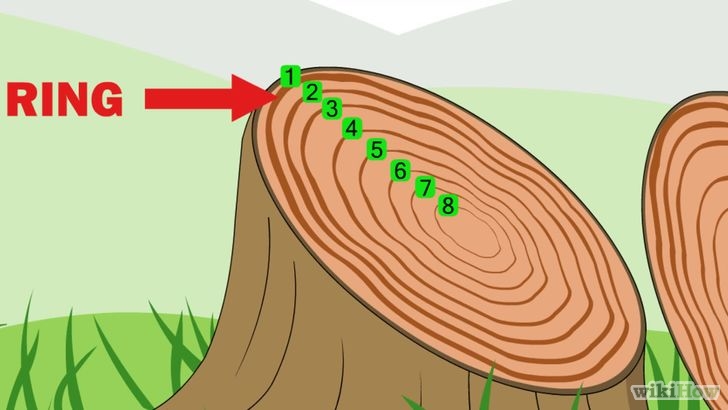
2. Count the rings on the stump.The number of rings indicates the number of years the tree lived. The rings are made up of bands of light- and dark-coloured wood.
Resources : Tree Age, Wikihow How to Determine the Age of Tree
The visual concept for my family chart will be designed according to the concept of tree rings based on the variables: generation, year of birth.
Mood Board
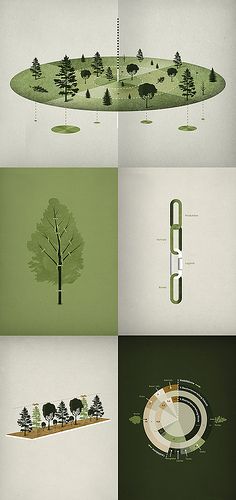

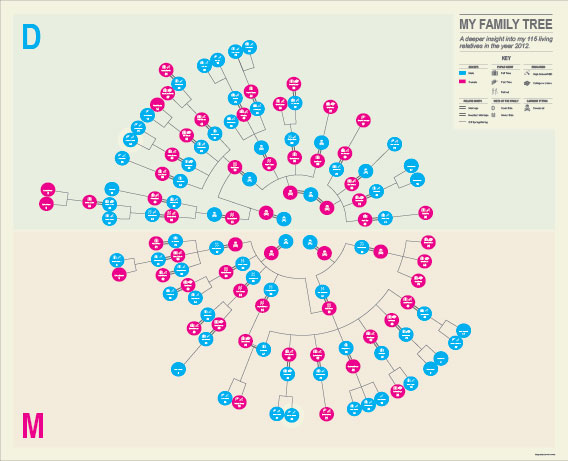
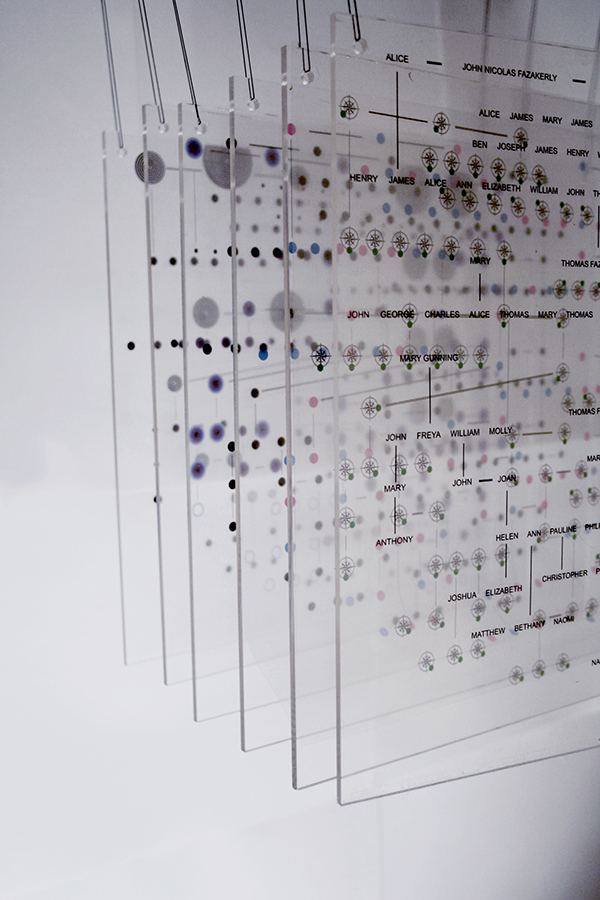

Study on Chinese name rule :
Yee Wu Jie Lee-Ling
Yee -> family name / surname
Wu Jie -> the middle name tells the order of a person’s birth within the family
Lee-Ling -> individual’s personal name
Surname will help us know our ancestors and the countries from which they emigrated. This is strictly followed in tradition Chinese family however nowadays it is more flexible. This can be visualized and summarized in my family tree.
Reference:
Chinese Immigrants, 1850-1900
By Kay Melchisedech Olson

Lín林 is a Chinese surname that is also used in Korea, Vietnam, and Japan. It is particularly common in southeastern China – specifically Fujian Province – and Taiwan. It is also common among overseas Chinese because many have origins in Fujian. It is pronounced and spelled as Lim because many Chinese descendants are part of the Southern Min diaspora and speak Min Nan. In Hong Kong, Macau and Vietnam it is spelled as Lam via Cantonese.

I am Malaysian. Lin this surname is quite common among the Malaysian Chinese community. However, because the vast majority of Chinese Malaysians romanized their surnames according to the pronunciations of their respective southern Chinese dialects, it is very rarely romanized as “Lin”. The Hakka, Hikkein, Teochew and Hainan communities romanize it as “Lim” whereas the Cantonese-speaking community uses “Lam”.
Actually I am not sure about the differences between Lim and Lam before I did this research. However, this reminds me that my father always told me about the story of my grandpa who have been experienced immigration from China Hainan province to Malaysia for having a better life. The story of how my grandpa started his kopitiam business (coffee shop) besides railway station. He sold Hainan style breakfast such as, coffee, tea, bread, Hainan style chicken chop etc. However, it is very pity that none of our family members have inherited the culinary style because my grandpa hoped that his children can have a higher education and guarantee job. Since my grandparents have passed away very early, so I really can’t get any accurate information or story from them. The only way is that get oral interview from my father and my relatives as well as research on the history of Malaysia Chinese Immigration.
Resource : https://chinese3c.wordpress.com/2012/02/13/lin-a-family-name-jeremy-lin/

Here is the summary of my research
Source: http://traditions.cultural-china.com/en/214Traditions11966.html
Family tree is a special cultural legacy of China, being one of the 3 important documents (history of the nation, local chronicles and family tree) of Chinese nation. Family tree is a precious human culture document, which is irreplaceable for the further study of history, folkloristic science, demography, sociology and economics.
The Origin of Family Tree
According to the inscriptions on bones or tortoise shells, bronzes, stones and other early inscriptions of China discovered, the history of family tree can be traced back to before Qin period at the latest. The officials of history wrote Generation Book – on Emperors in Zhou dynasty. The Generation Book written before Qin Dynasty has already been lost, and the one we are reading today is written by people in Qing dynasty. However, from the menu we can see that Generation Book has concluded all the family trees of emperors, kings and chancellors from Huang Emperor Period to Spring and Autumn Period, being a general pedigree chart of the comprehensive blood –related groups of previous and contemporary times.
The Form of Family Tree
Before written
oral family tree, knotting family tree
Other forms
mount chart (common people, merchants, rich families)
book-bind (bureaucrat families)
The Contents and function of Family Tree
The function of Family Tree changes from the past to now:
evidence of blood relationship (inheriting of title & property), content was simple, instruction of lineage -> Wei, Jin Dynasty, the chosen of officials and marriages based on family status, contents become more -> Song Dynasty, worship of ancestors and harmonizing the relationship of family members, popular among common people
The content of a family tree includes mainly 3 parts:
1) chart of lineage -> describing the generation and father of clan member
2) the main text -> name, title, father, generation, time, post, title of nobility, life time, posthumous name, marriage and so on of each member.
3) appendix
The order of generations is set in some family trees when they are being made. The generations are marked ahead of time. This is called “generations order” in folklore, which is actually assigning priority according to seniority. Because of the value the male child only formed by history, a character decided in advance has to be one of the characters of the “full name” of a male. This character should be in the middle or the last of the three characters of the name. The generations may be different, but the rule is accepted through common practice.
“Time is what keeps everything from happening at once”
“Time is the rate at which we live – the speed at which we successively pass through our existence from birth to death. Time is a rate of life-progress, different for every individual, and only made standard because we take the time-duration of the earth’s revolution around the sun, which is constant.”
Retrieved from “The Girl in the Golden Atom” By Ray Cummings
Idea process
These two paragraphs that retrieved from “The Girl in the Golden Atom” has inspired me a lot. Starting with the definition of time, I think that time is a human creation system that makes everything happens in an orderly sequence, and thus makes everything in that moment to be specific and unique. For example, the sun you can see out of the window is not the sun you are seeing right now because light takes time to reach us. That is why things are independent and ordered in sequences according to time (the past, now or future). Besides that, the starting of an individual’s time is when he is born and the ending of the time is when he dies. So this link to the life process from born to death. Birth is an addition to the family and death is a physical subtraction from the family. So this ends up to “FAMILY”.
Concept
My concept for TIME project is to design my own genealogy to demonstrate the order and seniority in my family. Also, discover the relationships between my family and the extended family based on the year of birth and generation. As this topic is very interesting to me because it is a sense of my responsibility to preserve the past for future generations and a sense of self-satisfaction in accurate storytelling in time. My ideal plan is to start from my grandparents, my father’s generation, my generation and the younger generation. There are 4 generations in total. It is interesting because there are some special cases happened in my family. For example, the age gap between my father and my cousin is quite near, and my nieces are older than me. So I would want to include this in my design too.
Other mindmaps
I found a very interesting calendar called Chinese Gender Chart which used to predict the gender of an unborn child based on two variables: the baby’s month of conception and the mother’s age. This 7,000-year-old chart, which is said to have been devised by an ancient Chinese scientist, was apparently discovered buried in a royal tomb near Beijing, about 700 years back. Its accuracy rate is said to be above 90 percent but till now there is no any scientific prove. Even though this is very interesting and fresh, however, there is limited research resource therefore I found very hard to continue on this topic.
Retrieved from: http://www.buzzle.com/articles/chinese-lunar-calendar-gender-predictor-chart.html